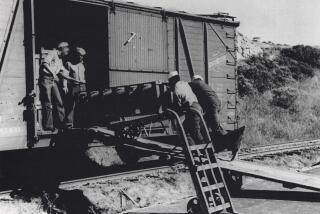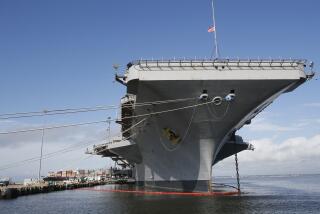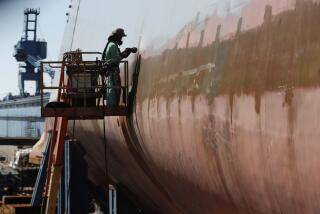Two Centuries of Seafaring on Display
- Share via
WASHINGTON — By early evening the battle for the city had been lost. The American commandant, following orders, lit the fuses, set the fires and destroyed the U.S. Navy’s leading shipyard.
The flames at the Washington Navy Yard in August 1814 fed on cordage, lumber, pitch and the wooden hulls of frigates and sloops.
“Fire spread to the mast and timber sheds and the joiners’ and boat builders’ shops,” writes author Anthony Pitch in “The Burning of Washington,” his recent account of the British invasion of the capital.
“Like a wheat field bending under the fierce winds, most buildings caved in one after the other. . . .”
Founded in 1799, a year before John Adams became the first president to occupy the White House, the Washington Navy Yard already had a history when Capt. Thomas Tingey carried out his orders to burn it to keep its ships and supplies out of British hands.
The yard’s history continued long after the British marched away and the War of 1812 ended.
The Navy is celebrating the bicentennial of a shipyard that for two centuries also has been a naval gun factory, a testing ground for ship design, a moorage for presidential yachts and a repository for the history of the Navy itself.
George Washington approved the site on the Eastern Branch of the Potomac River, now the Anacostia, opting for a location “under the eye of the government and as near the center of the United States as can be fixed. . . .”
The yard soon became the home port for the Mediterranean fleet projecting American power against the Barbary pirates.
The Navy carried home bronze cannon and stubby howitzers cast in Spain and Venice as trophies from the Barbary Wars. They were there when Capt. Tingey set his fires and still line the green lawn in the center of the yard, a short walk from historic houses that are quarters for senior officers, including the chief of naval operations.
The captured guns are the earliest of a large assembly of artillery and nautical hardware from two centuries of naval combat, including a gun turret from the battleship Maine and an anchor from the Hartford, Adm. David Farragut’s flagship at New Orleans and Mobile Bay during the Civil War.
The yard has a less tangible but still vivid collection of memories from its two centuries, many of them described in an illustrated bicentennial publication, “The Washington Navy Yard,” by Edward J. Marolda of the Naval Historical Center:
* President Lincoln, who liked the military gadgets and weapons the yard had to offer, often dropped by for coffee and conversation with the yard’s commandant and once fired a shot from a test version of a breech-loading carbine.
* The body of John Wilkes Booth, Lincoln’s assassin, shot dead by troops in Virginia, was brought to the Navy Yard on April 27, 1865. An autopsy was conducted in secrecy the next day aboard the ironclad monitor Montauk.
* Presidential yachts were berthed at the yard for decades, providing cruises for a long line of chief executives.
They included Sylph, used by William McKinley and Theodore Roosevelt; the huge Mayflower and its crew of 171; the much smaller Potomac and Sequoia; and the Williamsburg, acquired in Harry Truman’s time. The cruising ended in 1977 when Jimmy Carter sold Sequoia as an unwanted luxury.
Over time, the main activity of the yard shifted from building ships to making guns. Lincoln’s Navy Yard host, John A. Dahlgren, literally wrote the book on naval firepower, building the first ordnance shops and producing boat howitzers, rifled cannon and smoothbore Dahlgren cannon used extensively in the Civil War.
Dahlgren took command of the yard at the start of the war after its commandant and most of its officers defected to the Confederacy.
By the end of World War II there were 26,000 workers at the Navy Yard, producing guns and gear for the fleet. At war’s end, workers manufactured a large bronze plaque, which was fixed to the deck of the battleship Missouri where Japanese representatives signed the documents of surrender.
The Navy Museum at the yard displays its own duplicate of that plaque, along with professionally mounted exhibits from the age of sail to that of sea-launched missiles.
One new exhibit recounts the earliest days of the Navy Yard and takes its history full circle.
It is a bit of wood still attached to a shard of battered copper sheathing. The fragments are the only known remains of the frigate Columbia, burned in 1814 by Capt. Tingey and his men.
More to Read
Sign up for The Wild
We’ll help you find the best places to hike, bike and run, as well as the perfect silent spots for meditation and yoga.
You may occasionally receive promotional content from the Los Angeles Times.






